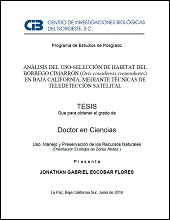Análisis del uso-selección de habitat del borrego cimarrón (Ovis canadensis cremnobates) en Baja California, mediante técnicas de teledetección satelital
Texto completo PDF:
Autor
JONATHAN GABRIEL ESCOBAR FLORES
Metadatos
Mostrar el registro completo del ítemResumen
La evaluación de hábitat del borrego cimarrón es fundamental para determinar la distribución y el número de individuos que puede soportar un área. En esta investigación se utilizaron técnicas de teledetección satelital para analizar la disponibilidad y el uso-selección, de tres componentes esenciales del hábitat que realiza el borrego cimarrón en Sierra Santa Isabel: agua, terreno de escape y cobertura vegetal. Se identificaron 11 aguajes que son utilizados por los borregos, de los cuales El Zamora (n = 120) y El Cordero (n = 67) tuvieron los mayores registros. Los sitios con mayor disponibilidad de terreno de escape fueron seleccionados por grupos de hembras y añeros (χ² = 9.83, P ˂ 0.05), mientras que grupos de adultos de ambos sexos seleccionaron sitios con una menor disponibilidad. En el período seco los borregos seleccionaron los sitios con baja cobertura vegetal (χ² = 11.58, P < 0.05), y durante el período de lluvias en solo una de las localidades de estudio seleccionaron los sitios con mayor cobertura (χ² = 8 .72, P < 0.05). Para el período de pos-lluvias no se encontró una relación entre la cobertura vegetal y la distribución del borrego cimarrón. La selección del terreno de escape y cobertura vegetal por el borrego cimarrón se relacionó con su estrategia anti depredadora. El mayor registro de hembras ( n = 140) y añeros ( n = 62), aunado al hábitat no fragmentado y la disponibilidad de agua permanente, confirman la importancia de Sierra Santa Isabel para la reproducción, crianza y reclutamiento del borrego cimarrón en Baja California. El análisis de imágenes satelitales, facilitan la ubicación y permiten la evaluación de hábitat óptimos, esenciales para el monitoreo y manejo de poblaciones de borrego cimarrón. The assessment bighorn habitat is essential to determine the distribution and the number of individuals who can support an area. In this research satellite remote sensing techniques were used to analyse availability, use and habitat selection carried out by the bighorn sheep in Sierra Santa Isabel. The study used three essential components: water, escape terrain and cover vegetation. Of the 11 water holes that are used by bighorn sheep, Zamora (n = 120) and El Cordero (n = 67) had the highest records were identified. Sites with greater availability of escape terrain were selected by groups of ewes and yearlings (χ² = 9.83, P ˂ 0.05), while groups of adults (rams and ewes) selected sites with lower availability. In dry season bighorn sheep selected sites with low vegetation cover (χ² = 11.58, P < 0.05), and during the rainy season in only one of the study sites selected sites with greater coverage (χ² = 8.72, P < 0.05). For the period post-rainfall no relationship between vegetation cover and distribution of bighorn sheep was found. Site selection of escape terrain and vegetation cover by bighorn sheep was correlated with its anti predatory strategy. The greatest record of ewes (n = 140) and yearlings (n = 62), coupled with the unfragmented habitat and availability of permanent water, confirm the importance of Sierra Santa Isabel for breeding, raising and recruitment of bighorn sheep in Baja California. The analysis of satellite images facilitate location and allow optimal evaluation, essential for monitoring and management of populations of bighorn sheep habitat.

